The Battle of Gettysburg… an intimate look…
November 7, 2022 by Laura Heilenman · Leave a Comment
I would imagine, as a journalist, an eyewitness is the “rare pearl”. Research is all well and good but interviewing someone who saw it with their own two eyes will most often give the very best information. So it was for the journalist who wrote for the DAILY RICHMOND EXAMINER, July 17, 1863 issue. The article…
“The Invasion of Pennsylvania–The Battle Of Gettysburg–The Retreat To Hagerstown” features an eye-witness account of the retreat and is prefaced with: “…the only connected, intelligent and intelligible account that has yet been given to the public of the movements of General Lee…after the Battle of Gettysburg.” This lengthy & detailed accounting by one of the soldiers begins with the Confederate advance from Virginia into Maryland on June 18, then continues with: “On Friday, 26th, we took up the line of march through Chambersburg on the Harrisburg road. The splendid band in the 4th Louisiana brigade…proceeded the column playing ‘Dixie” and the Marseillaise…We passed through Shippensburg to the sound of martial music again & went on to Carlisle…Harrisburg was in a panic…”.
A report from a soldier who was more than an eyewitness of the battle; rather, one who experienced it first-hand… From a journalist’s point of view, it just doesn’t get any better. 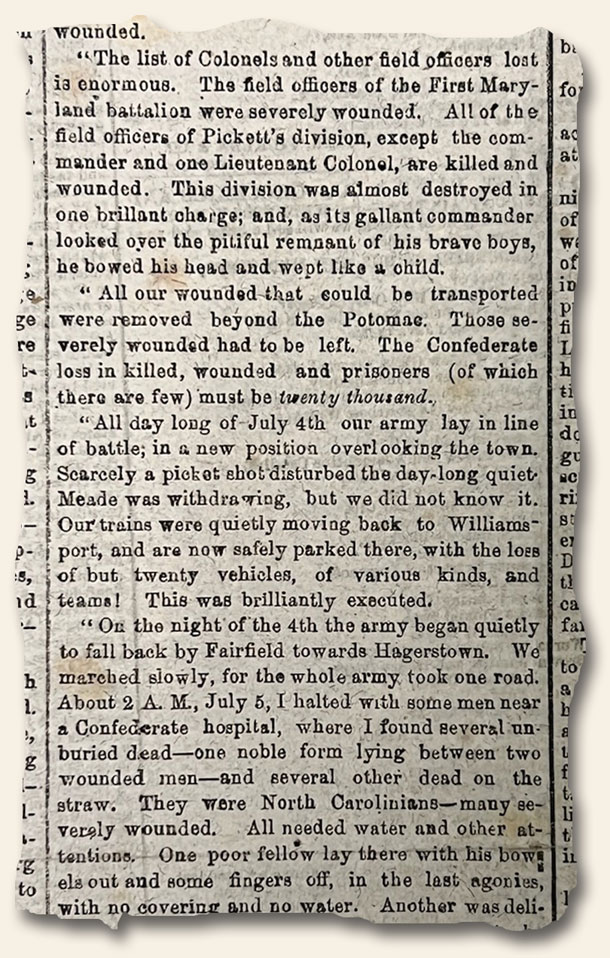
An oddity from 1863 – The Battle of Gettysburg…
September 9, 2022 by GuyHeilenman · Leave a Comment
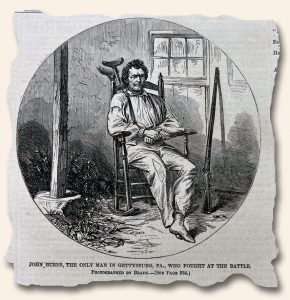 I don’t know about you, but if my town was occupied by enemy troops and the battle was ragging all around me, I’m thinking I would likely take up arms and join my fellow compatriots – and a host of my neighbors would certainly do the same. So, when I recently saw the illustration of “John Burns, the only man in Gettysburg, PA, who fought at the battle” on the cover of the August 22, 1863 Harper’s Weekly, I was perplexed. I understand the majority of able-bodied men were likely off to war elsewhere, but to think no one was left to “defend the home-front” other than this one man is a bit confounding. The writer of the corresponding article also took note of this curiosity, and his comments are posted below.
I don’t know about you, but if my town was occupied by enemy troops and the battle was ragging all around me, I’m thinking I would likely take up arms and join my fellow compatriots – and a host of my neighbors would certainly do the same. So, when I recently saw the illustration of “John Burns, the only man in Gettysburg, PA, who fought at the battle” on the cover of the August 22, 1863 Harper’s Weekly, I was perplexed. I understand the majority of able-bodied men were likely off to war elsewhere, but to think no one was left to “defend the home-front” other than this one man is a bit confounding. The writer of the corresponding article also took note of this curiosity, and his comments are posted below.
This statement was written shortly after the battle, and often, as time goes on, new information is unearthed. With this in mind, if anyone has information which would refute this claim, please send us a note and we will update this post. Thanks in advance.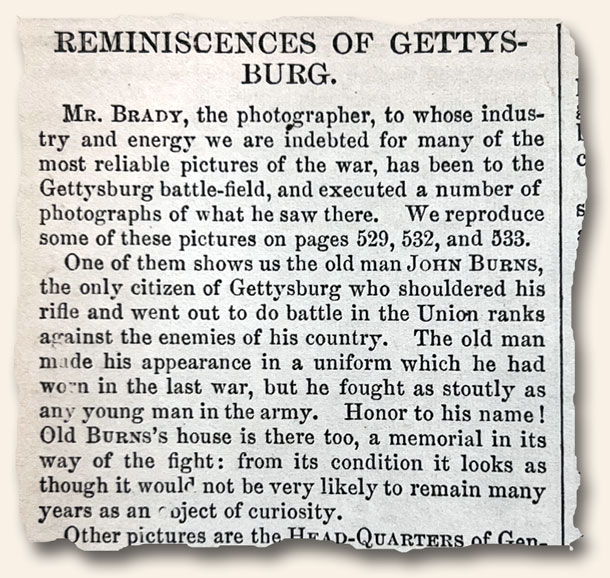
Where History Comes Alive (Part 2)… Gettysburg…
December 13, 2021 by Laura Heilenman · Leave a Comment
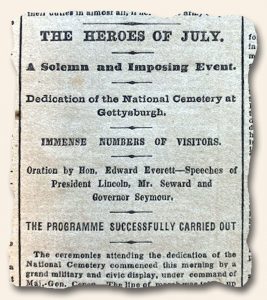 The Battle of Gettysburg, occurring roughly at the midpoint of America’s Civil War, was both the deadliest battle and the turning point of the war. An interested historian can traverse this soil where American struggled against American to uphold their way of life and protect their convictions and experience the humbling and somber journey which befalls those who explore first-hand the sacred ground which helped define the America we experience today. In the past, when I have personally been blessed to walk upon the sacred soil where so many gave their lives, I could almost hear Abraham Lincoln’s clear and determined voice echo over the valleys: “Fourscore and seven years ago our fathers brought forth on this continent, a new nation, conceived in Liberty, and dedicated to the proposition that all men are created equal...“.
The Battle of Gettysburg, occurring roughly at the midpoint of America’s Civil War, was both the deadliest battle and the turning point of the war. An interested historian can traverse this soil where American struggled against American to uphold their way of life and protect their convictions and experience the humbling and somber journey which befalls those who explore first-hand the sacred ground which helped define the America we experience today. In the past, when I have personally been blessed to walk upon the sacred soil where so many gave their lives, I could almost hear Abraham Lincoln’s clear and determined voice echo over the valleys: “Fourscore and seven years ago our fathers brought forth on this continent, a new nation, conceived in Liberty, and dedicated to the proposition that all men are created equal...“.
As moving as this trek is, coupling the venture with actual accounts of the day gives a deeper insight of this nation-shaping event. If you ever have the opportunity to visit Gettysburg, it will be more than worth your while. However, before you set out on this adventure, you may want to peruse some of the contemporaneous reporting found within the authentic newspapers of the day. After all, it has been said: “History is never more fascinating than when it’s read from the day it was first reported.“
Snapshot 1863… A slave mother’s attempted escape…
January 11, 2021 by GuyHeilenman · Leave a Comment
We recently discovered a heart wrenching account of a slave mother’s attempted escape with her child on an inside page of a New York Tribune dated January 29, 1863. Editorializing on my part will not do it justice. It is accounts like this one, which were part of everyday life for many who were living in bondage, is a continual reminder that I will never be able to comprehend what it’s like to walk in the tattered shoes of a slave.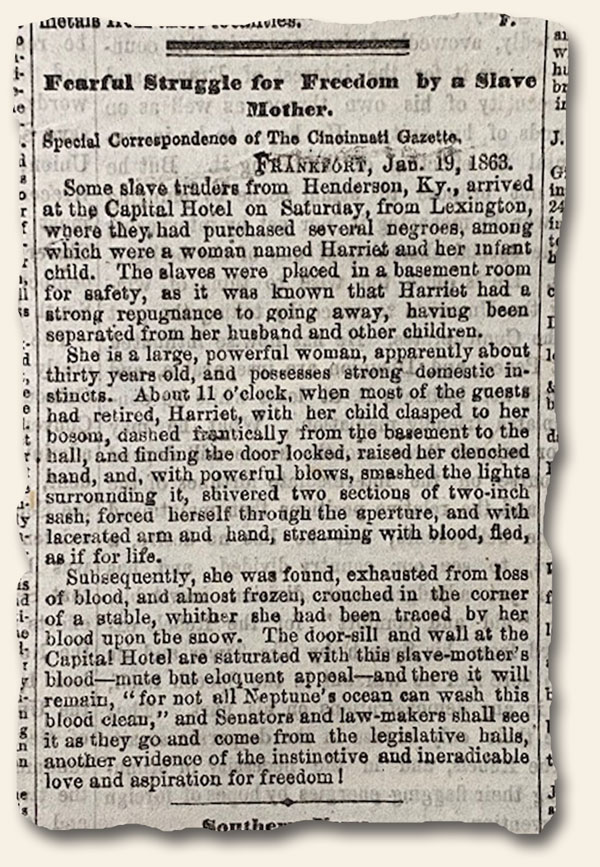
Snapshot 1862… Civil War inner-family strife takes its aim at Lincoln…
June 11, 2019 by GuyHeilenman · Leave a Comment
The following snapshot comes from The Crisis, Columbus, Ohio, dated May 7, 1862, which printed the death report of Abraham Lincoln’s brother-in-law, and includes considerable Lincoln-directed angst.
Nobody like me, everybody hates me… 1863…
August 27, 2018 by GuyHeilenman · 33 Comments
Nobody likes me, everybody hates me
I think I’ll go eat worms!
Big fat juicy ones
Eensie weensy squeensy ones
See how they wiggle and squirm!
Down goes the first one, down goes the second one
Oh how they wiggle and squirm!
Up comes the first one, up comes the second one
Oh how they wiggle and squirm!
I bite off the heads, and suck out the juice
And throw the skins away!
Nobody knows how fat I grow
On worms three times a day!
Nobody likes me, everybody hates me
I think I’ll go eat worms!
Big fat juicy ones
Eensie weensy squeensy ones
See how they wiggle and squirm!
When a child sings, “Nobody Likes Me,” rarely does it inspire the reaction (from those within listening distance) hoped for. The reality is, the child may be down in the mouth, but they’re likely not going to eat worms. After all, who would do such a thing? Of course we forget the times throughout history when many have chosen to do so as a result of severe famine, long sea voyages (where food was scarce – and refrigeration was limited), and of course, in the present as a means of what we often call entertainment on a plethora of reality television shows. Speaking of the latter, when such is put upon others against their will, the result is no laughing (or entertaining) matter. Perhaps it is the contrast between a willing act and one which is unjustly perpetrated upon others which drew my attention to the following article found in the New York Daily Tribune, September 3, 1863: 
PS Please don’t respond with comments stating this post was in bad taste. I realize the song itself is sung with tongue firmly planted in cheek – just for fun.
Snapshot 1863… same-year review of “Les Misérables”…
July 19, 2018 by GuyHeilenman · Leave a Comment
The following snapshot comes from The Atlantic Monthly, July, 1863…
The best of the best from the mouth and/or hand of Abraham Lincoln…
September 25, 2017 by GuyHeilenman · Leave a Comment
What is Abraham Lincoln’s most noteworthy speech, proclamation, letter, etc.? The Emancipation Proclamation? His Thanksgiving Proclamation or proclamation for a National Fast Day? Perhaps it was his 1862 Annual Message to Congress, his 2nd Inaugural Address, or his last public address in 1865? Of course the “go to” answer is often what we now refer to as The Gettysburg Address. The choices are almost endless. However, below is a candidate which appeared in an issue of The Crisis (Columbus, Ohio, May 4, 1864) I’d like to throw into the mix. Why it flies under the radar of notoriety and has never received more recognition is rather perplexing. What are your thoughts? Note: I’d like to thank a friend of Rare & Early Newspapers for suggesting I take a 2nd look.
Introducing: RareNewspapers.com – The Civil War…
September 29, 2016 by GuyHeilenman · 2 Comments
Collectible Civil War Era Newspapers
 “History is never more fascinating than when it’s read from the day it was first reported.”
“History is never more fascinating than when it’s read from the day it was first reported.”
Records of a Nation in Turmoil
In the 1860s, Americans’ interest in the Civil War, and its collateral effects, caused a spike in demand for news reports. These were days of heightened concern, and newspapers were one of the few resources that people were able to rely upon for war news.
Aside from specific war news, Civil War newspapers also reported on citizens’ reactions to how the war was shaping the American economy and politics, and opinions about slavery.
Reading an authentic Civil War newspaper and holding the original print paper between your fingers will transport you to the frontlines of battle, and provide a glimpse into the psyche of Civil War-era citizens, politicians, and soldiers.
Original Civil War newspapers are genuine pieces of American history a collector or anyone interested in American history must have.
Harper’s Weekly
Harper’s Weekly was one of the most popular newspapers during the Civil War. Although its base was in New York, its moderate stance on slavery (pre-war) was seen as a way not to upset the newspaper’s Southern readership. However, once the Civil War began, President Lincoln and the Union received Harper’s complete loyalty and support.
As the war went on, the many illustrations and prints from Thomas Nast and Winslow Homer provided a vivid visual account of the battlefields, the people, and the bloodshed—”I’m hoping next week’s edition will show scenes of the battle of Fort Sumter in Charleston Harbor. I’ve read all about it, now I want to see it!” – A Harper’s Weekly reader in 1861. Another Harper’s reader noted, “I look forward to the end of the month and seeing just what transpired at Charleston.”
The illustrations and prints from Harper’s Weekly remain striking in both their detail and artistry. We have several noteworthy issues of Harper’s Weekly in our inventory.
Civil War People & Generals
The Southern States’ call for secession from the Union grew louder after the election of Abraham Lincoln in 1860. A disagreement between President Lincoln and Confederate leader Jefferson Davis over control of Fort Sumter led to overwhelming demand for war. Many men began enlisting for military service shortly after the battle of Fort Sumter.
Our vast inventory of genuine, historic Civil War newspapers highlight the efforts of military heroes from the North and the South that we have all come to know, including Ulysses S. Grant, George McClellan, Robert E. Lee, George Meade, “Stonewall” Jackson, William T. Sherman, and more.
Significant Civil War Battles & Events
Battle reports were common, including struggles at Fort Sumter, Bull Run, Manassas, Antietam, Shiloh, Gettysburg, Chickamauga, Vicksburg, Fredericksburg, Richmond, and so much more.
We have newspapers covering the first shots at Charleston Harbor to the final surrender at Appomattox, plus the Lincoln assassination.
Southern Illustrated News
The Southern Illustrated News was to the Confederacy what Harper’s Weekly was to the Union. Based in Richmond, Virginia, Southern Illustrated News had a rather ornate masthead and its front pages regularly featured portraits of notable Confederate figures, such as Robert E. Lee, “Stonewall” Jackson, and John S. Mosby. Southern Illustrated remains one of the most sought-after Civil War-era titles in the collecting hobby to date. Visit our Southern Illustrated Pinterest board to view several interesting portraits.

Reporting the Civil War
Before the start of the war, there were 3,725 newspapers in the United States. American newspapers accounted for one-third of all newspapers printed in the world. Most of them were weeklies. At the time, standards for what constituted sound, thorough, and responsible journalism did not exist on the eve of the war, according to Ford Risley, a Civil War journalism expert and head of the Department of Journalism at Penn State University.
Newspapers printed news dispatches, editorials, illustrations, maps, and various other tidbits, such as President Lincoln’s famous letter to Mrs. Bixley “…to have laid so costly a sacrifice upon the altar of freedom.” At times, the dispatches were entirely hearsay and wildly inaccurate, such as this series of short reports from the Daily Journal of Wilmington, NC or this report from the New York Tribune stating that Stonewall Jackson was “Dead Again.”
The Reporters
Reporters were a diverse group. Some had previous experience, but many reporters were lawyers, teachers, clerks, bookkeepers, and ministers. Their levels of education ranged from Ivy-league educated to only basic schooling.
Civil War reporters faced many difficulties, among them uncooperative and unreliable sources, difficulties with dispatching reports back to their newspapers, and even death. One correspondent closed a story with “Your readers must pardon a short letter. No man can write in a happy vein or style while minnie [sic] balls are flying uncomfortably close to his head.” Needless to say, conditions for Civil War reporters were not safe or ideal. More on how reporters lived and worked can be found here.

Unique Printing and Reporting Conditions
After the Union won the Battle of Memphis in June 1862, the Memphis Daily took to the road and became known as the Moving Appeal. During just a four-year period, this newspaper published in nine different cities.
A truly one-of-a-kind newspaper was “printed on board Steamer Des Moines” on blue-lined ledger paper in 1864. This issue also contains a letter written by a soldier to his wife. Letters from soldier correspondence frequently contained glorified accounts of battlefield glory meant to inspire confidence in the readers back home. Occasionally, letters from soldiers had reliable news and insights.
—————————–
Much more can be said regarding newspapers from the Civil War, but for now, please enjoy the Rare Newspapers dedicated page dedicated to original and historic issues from this era:
The Civil War
“All the News That’s Fit to Print”… one editor gets it right…
September 5, 2014 by GuyHeilenman · Leave a Comment
While the remainder of the newspaper seems to overwhelming contradict an editorial comment made by a contributor for the Southern Sentinel (Louisiana) in the issue of October 24, 1863, one can certainly appreciate his honest approach to reporting. I dare to say this could not be printed in most current-day newspapers with any degree of integrity. Please enjoy:



